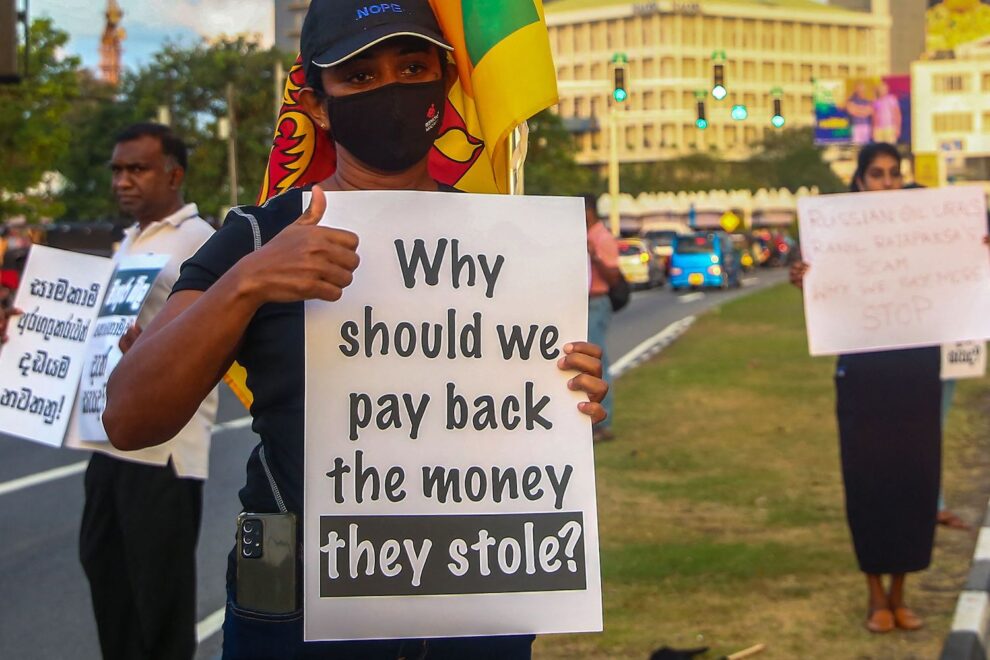Toronto, Atlanta (28/11 – 20)
A wise old expression intones “Behind every bad borrower is a bad lender”. Like many such cute, amusing aphorisms, it is accurate as far as it goes … but what if?
What if a loan approval is held up, then granted, after a couple of phone calls from the office of the Vice President? What if the borrower is a crony or relative of Mr. Big, which is what practically bankrupted Indonesia, when the Soeharto vampire children took out multi-hundred-million-dollar “loans” (wink wink) for projects whose profit-making potential was near zero?
What is the potential borrower tells you that he knows your daughter is in medical school, and implies a carrot-or-stick reaction to the granting of a loan, plausible or implausible? Will she suddenly be framed for a narcotics charge? Will she simply disappear one lonely night? Or will she be graciously accepted into one of the finest, most expensive clinics in the land, as a junior physician? Depends on that loan approval, buddy.
Magnify this to a national or global level. Nations grant loans often contingent, in an implied or explicit fashion, on the recipient purchasing from them. A “defense loan” or “grant” from the USA may hinge on the purchase of overpriced, maintenance-intensive, soon-obsolete weaponry which may or may not work: the military-industrial complex is concerned with profits, not effectiveness.
Take the Lockheed F-104. Go ahead, take one. (Nobody else wants them.) How many pilots in Occupied Germany, oh sorry, the Federal Republic of Germany have come to grief in the stubby-winged fighter jet? Here, don’t bother, Bing will save you the trouble: “According to the International F-104 Society, Germany lost 292 of its 916 F-104 Starfighters and 116 pilots from 1961 to 1989. The high accident rate of the F-104 earned it the nickname ‘Witwenmacher’ or ‘widowmaker’ from the German public.”
Would you buy a car with an accident history like that? Maybe if the terms were great, and Lockheed, in league with Uncle Sam, undoubtedly offered terrific E-Z Time Payments to the German Government to buy those sweet fighters. The widows may moan and bawl but for the big fellows in industry and government, it’s “…just doing business…” Killing Germans was never such a big bother for them, either.
Flash-forward to Century 21.
The West is [mock]-outraged that the People’s Republic of China has followed the model, diverting some of those trillions of chancy fiat dollars, a tsunami of wealth following the Reagan-era offshoring of American manufacturing to the Middle Kingdom (with the added bonus of deindustrializing the USA), into developing countries for infrastructure projects, through its “Belt and Road Initiative” (BRI), also known as “One Belt, One Road” (OBOR).
The global development strategy was initiated by the Chinese government in 2013 for infrastructure projects, ideally promoting their concept of “economic cooperation” with raggedy-ass, flat-broke countries across Asia, Europe, and Africa.
Why would Communist China do that, apart from the urgent need to unload its trillions before the pranksters in Washington suddenly drastically devalue the American Rupee? (PROTIP: Your dollars will suddenly and magically become worthless museum pieces, like their Zimbabwe counterparts, when their trillions of debt bite hard).
Well, because the People’s Republic of China wishes to extend a hand of friendship and cooperation to fellow developing nations, in a benevolent spirit of international harmony and global progress.
What’s that pouty face you’re making? You don’t believe? OK, try this: China gives loans to profligate deadbeats who can’t possibly pay them back, for projects ranging from borderline to worthless, with a smart ulterior motive on the part of the clever Orientals.
Borderline: The Standard Gauge Railway (SGR) in Kenya, funded and built by China for a cool $3.2 billion, with a second phase costing $1.5 billion. Built to connect the port city of Mombasa to the capital city of Nairobi, and later extended to Naivasha, it sort of made economic sense: get those chickens and veggies and fish to market in the capital more quickly and efficiently. Give tourists a nice train ride.
Yes, yes – but does that justify going into the hole for nearly US$ 4 billion? Sounds like a pack of roving gypsies buying a Lamborghini (as opposed to stealing one, which is their customary style), simply because the car dealer (holding too much inventory) agrees to a fifty-year time payment plan on the car.
The Kenyan deal clicks into a logical strategy when you consider that Mombasa would make a fine and dandy PLA naval base, complementing the one the Chinese already built on the coast of Djibouti.
Watch what happens when a fresh new Kenyan government comes whining and wringing their hands with “Sorry we weren’t the ones who agreed to the loan, and we can’t pay you back quite yet”. Just watch. Indonesia take note – those billions owed to the PRC will come due as well.
ÜBER-Worthless: tragic, desperate Sri Lanka, ripped apart by two decades plus of civil war, and nothing worthwhile to export – one of the “basket cases” famously described by Henry W.C. Kissinger. They don’t even have a decent sex trade to attract moneyed tourists, unlike Thailand or the Philippines.
When a reckless, desperate (& notoriously corrupt) government started to “print money” to cover deficits, inflation obediently followed, rocketing to 60 percent by June 2022. A Chatham House study: “Sri Lanka’s debt crisis was made, not in China, but in Colombo, and in the international (i.e. Western-dominated) financial markets.” Heard those lyrics before, Reader?
That brings us to the sad story of Hambantota Port, a narrative of political and economic incompetence, facilitated by lax governance and inadequate risk management on both sides. Repeatedly shot down by experts, with multiple feasibility studies showing Hambantota couldn’t compete with the thriving Port of Colombo, the largest in Sri Lanka, which also had plenty of potential for expansion.
What if I told you that former President Mahinda Rajapaksa, an emperor of corruption, conspired with the PRC to build it? Rajapaksa wanted political power, from reviving his home region and main political base, where the gigantic port was to be built. China, the only candidate to proffer a loan when all the other borrowers shied away, saw a way to a military and commercial foothold in the region, as the authorities trumpeted how they would deliver “the biggest port constructed on land in the 21st century”.
Well, the inevitable punch line: Hambantota fared so badly, mostly ignored by thousands of ships passing it by daily, that it eventually defaulted on its debts, and the Sri Lankan Government had little choice but to hand over 80% of the port’s ownership to China, as well as a large swathe of surrounding land on a 99 year-long lease. No non-Chinese allowed inside any longer, sorry.
Even if the “debt vultures” demanding full repayment are thwarted, and a deal with creditors is reached, Sri Lanka will still be burdened by a huge debt liability that can only be ‘serviced’ by cuts in the already low living standards of 22m Sri Lankans. The IMF has already indicated it will encourage austerity in Sri Lanka – reducing spending and increasing taxes. Sorry mama – no government-sponsored free milk or medical examinations for your baby. And we can’t fix that bridge that fell down, either.
It is reported that wild animals have begun to creep into the abandoned structures at Hambantota Port, seeking burrows and nests in the lonely, unused infrastructure. Hey, maybe the facility can be repurposed as a “Hambantota Wildlife Refuge”, and attract tourists that way.



































